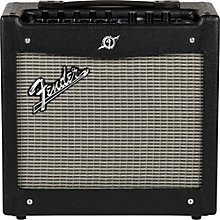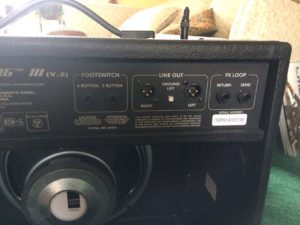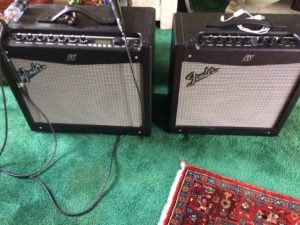Buy Richard Hunter’s Huntersounds Patch Set for Fender Mustang Series Modeling Amps!
PLEASE READ THIS!
Fender has announced that as of March 20 2020 they have dropped support for Fender FUSE software, meaning for computer support for the Mustang I-V series amplifiers. However, Fender advises that the software can still be downloaded from the following locations (copy and past the URL(s) below into your browser address window):
Mac version: https://www.fmicassets.com/fender/support/software/fender_software/fender_fuse/mac/FenderFUSE_FULL_2.7.1.dmg
Windows version: https://www.fmicassets.com/fender/support/software/fender_software/fender_fuse/pc/FenderFUSE_FULL_2.7.1.exe
This software should run on current Windows operating systems–we’re running FUSE on a Windows 10 machine right now. It appears that the latest Mac OS updates broke FUSE, but there is an alternative: an app called Remuda runs on Android OS, and it does just about everything FUSE does. We’ve tested it ourselves with an Android phone from AT&T ($31), a USB-C to USB OTG cable ($5) and the Remuda app ($7), and it all works fine. If you’re having trouble with your Mac and FUSE, this is probably the cheapest alternative, and it’s fully functional. We can supply our Mustang series patch sets in that format if a customer prefers.
Richard Hunter’s Huntersounds Patch Sets Make Any Fender Mustang Amp a One-Stop Shop for Amplified Blues Harp

We sell a lot of patch set licenses for the Digitech RP and Zoom G3 devices, and our customers like ’em just fine. But some people want an all-in-one solution that puts the amp and the amp modeler in the same cabinet. And many harp players want the familiar and enjoyable experience of playing through an amp onstage and in studio, especially if they don’t have to learn to program something to do that.
If that’s you, we’ve got the goods you want and then some. Our patchsets for Fender Mustang I/II/III/IV/V/Mini amplifiers put 24 blues-and-rock-ready harmonica tones for the Mustang I/II/Mini, and 40 for the Mustang III/IV/V, at your disposal with one load from your computer to the amp. Once you’ve loaded those sounds into your Mustang amp, you turn one dial to bring up any of those sounds on stage or in studio–hot, wired, and ready to rock. It’s that easy and powerful.
The Fender Mustang series amps are a great bargain for harp players!
The Fender Mustang series amps went out of production (all except the Mustang I) in mid-2017, so they’re pretty close to the state of the art. Fender made a lot of them, and they were reviewed very well. But they’re not quite as simple to operate as a traditional tube guitar amp, and some people just don’t like learning curves. (One of the things my patch set does is eliminate the learning curve.) The result is that there’s a steady supply of Mustang amps on the used market selling at low prices in good-to-great condition. Add my patch set to one of those and you’ve got a killer blues harp setup–actually, a bunch of killer blues harp setups–ready to go for short money.

Buy a used (v.2) Mustang III, IV, or V from guitarcenter.com and load it with our patches, and you’ve got the equivalent of dozens of great harp setups in one easy-to-use gig-ready amp. Used Mustang III’s in good to great condition are selling for $250 or less now, Mustang IV’s go from $300-400, and Mustang V’s with Fender’s Mustang V 4×12 cabinet are selling together for around $400. If you go with a Mustang I, II, or Mini for home/studio use instead, the amp plus my patches will run you less than $150. That’s about the best deal we know of for a great harmonica-ready amp, and nothing in that price range comes close in terms of sheer blues harp tonal variety.
Click here if you’re ready to order!
The Huntersounds patch sets unleash the power of the Fender Mustang series amps for harp
Richard Hunter’s Huntersounds patch sets for Fender Mustang series amps turn your Fender Mustang I/II/III/IV/V/Mini amp into an incredibly powerful blues harmonica setup for stage and studio.
You get dozens of “patches” (pre-configured sound setups) for your Mustang amp in both single patch and bulk load format, ready for loading into your amp via a USB connection to your computer using free software provided by Fender. These sounds are designed to meet the needs of amped blues and rock harmonica players for straight-up amped blues and rock sounds without a lot of frills. A full range of Fender and other classic harp amps is covered in these patches, with a wide range of blue tones, from very aggressive to semi-sweet. We even include a few clean patches with nothing but reverb for the acoustic blues and vocals in your repertoire.

We’ve tweaked every patch in this set over and over to yield maximum volume and tone without feedback. The result is a big batch of bold, amped-up Chicago blues setups, plus enough variety in reverbs, delays, and occasional FX like low octave doubles and rotating speakers to add some rock juice to the mix. All of these sounds are immediately usable on stage and in the studio, and the only control that’s new to anyone who’s used an amp is the big dial that you turn to change from patch to patch. One movement of the dial is all it takes to change from a honking Bassman sound to a screeching Silvertone sound to a smooth, cool ’65 Twin reverb sound, to a simple reverb-only sound for vocals and acoustic harp. It’s not just a great amp–it’s a lot of great amps in one box.
(One thing a Mustang amp won’t do is run on batteries. If you need a device that runs on battery power, check out our patch set for the Zoom G3/G3x.)
Our latest patch set for the Mustang III v.2 and up includes 40 patches. Our patch set for the Mustang I/II/Mini includes 24 patches taken from the 40 that make up the M3 set. Both sets sell for about a dollar per patch. (That’s a bargain. We want our sounds in your Mustang!)
You can download complete current layouts and descriptions for each of our Mustang patch sets by clicking on the links below.
Huntersounds Fender Mustang III-IV-V patch list v1
Huntersounds Fender Mustang I-II-Mini patch list v1
Check Out the Sounds
Go check out the video above now if you skipped it earlier. The gear I used to play these licks includes a Seydel Session Steel harmonica in A, a Shure SM58 mic, a Mustang III v.2 amp loaded with my patch set, and nothing else; no post-recording audio editing was done. This is what the Mustang loaded with our patches sounds like to the built-in mic on the video camera, at close range, at moderate volume, with a mic that’s pretty widely used by harmonica players. (By the way, the Audix Fireball or Fireball V is currently not our favorite mic for this amp and patch set. The enhancement of low frequencies via proximity effect is pronounced in the SM58, and it makes the overall sound a lot punchier at gut level.)
If you’re on a low-bandwidth connection, you can stream an mp3 audio of the samples instead if you prefer.
Audio Player
Click here if you’re ready to order!
We make it easy
Each patch set ships with a full set of documentation that describes every patch in the bulk load set. All sets ship with a full set of instructions that tell you how to load the patches into your Mustang v.2 amp and use them and the amp in performance. (There’s a lot of real-time control on the front panel of a Mustang III.) The entire collection of patch files weighs in at about 1.4 megabytes, so it will download easily even on a dial-up Internet connection. All buyers also get a year of FREE updates to the patch set, meaning that every time we add or update a patch in the base set during your first year as a licensee, we send it to you. Finally, we provide email support for our licensees. Our goal is to get you up and running with your Mustang amp, making great music, as quickly and easily as possible.
FAQ
Q: Which Mustang amp should I buy?
A: Most of the Mustang amps are out of production now; the Mustang I, the smallest amp in the series, is the only one still in production, so if you want to buy new it has to be a Mustang I, which is not loud enough for a performance unless it’s in your bedroom. The Mustang I and Mini are fine for recording, practice, and light jamming; the same could be said of the Mustang II, which is a little bigger and louder, but (like the Mustang I) lacks important features for performance (such as a display that tells you what sound is up), as well as minimum essential pro features like a line-out and FX loop.
If you plan to gig with the amp then the best choices are the Mustang III and Mustang IV, both of which are readily available in good to great condition on the used market at prices ranging from $200-250 for the Mustang III and $300-400 for the Mustang IV. (Check eBay, guitarcenter.com, and so on.) The Mustang III has one 12″ speaker and 100 watts, the Mustang IV two 12″ speakers and 150 watts. The Mustang V has 150 watts and requires an external speaker cab, i.e. it’s the amp head only. All three have pro features like an external FX loop and XLR line outs for connection to a PA or recording console. If you’re willing to consider a two-piece setup and want the biggest Mustang rig you can get, the Mustang V with matching Mustang V stereo 4×12 speaker cab is a good and very economical choice at about $400 in great condition. If you want maximum power in a self-contained package, the Mustang IV is tops. If you want something a little more compact with the ability to connect to the PA for more grunt, get the Mustang III. Make sure to get the v.2 version of any Mustang. The previous version of the Mustangs suffered from certain audible electronic glitches that were fixed in the v.2 series of these amps. We repeat: Make sure to get the v.2 version of any Mustang.
We don’t advise buying a Mustang I or II (or Mini) unless you’re sure you’re going to be using it to play at home only. If that’s the case, the Mustang II is louder and not much bigger, and only a little more expensive used. You’ll be heard at more garage jams with that amp. But the Mustang I takes up less space in your studio or bedroom, and is certainly loud enough for either, so if that’s where you’re planning to play it, that might be the way to go.
Click here if you’re ready to order!
Q: What else do I need besides the patch set?
A: You’ll need:
PLEASE NOTE: in order to use our patch sets, you will need to extract the patches from a ZIP file, and download and install Fender’s FUSE software. If you’ve ever installed any kind of software on your computer before, then you probably know how to do this. If not, then you need to get someone to help you. Anyone who’s moderately skilled in using their computer should be able to guide you through the process, which takes less than 10 minutes if you know what you’re doing. WE DO NOT PROVIDE BASIC COMPUTER SUPPORT. Our READ ME file contains detailed instructions on how to do the setup.
ALSO PLEASE NOTE: we’ve had trouble installing the FUSE software on two different Mac computers. From a look at the Fender forums, it seems that others have had similar problems. Installation on PCs is smooth and quick; installation on the Mac involves multiple steps, and apparently can go wrong. We are working on this issue. In the meantime, you are likely to enjoy the experience of installing FUSE more if you’re installing it on a PC.
Click here if you’re ready to order!
Q: Can the Huntersounds patches be used with any of the amps in the Mustang series?
A: The single patches are interchangeable between every Mustang series amp (except, I presume, for the new GT40 and GT100). The bulk load files are specific to the Mustand I/II and III/IV/V respectively.
Q: What styles of music will this patch set work for?
A: You can play anything you like with these patches, but we basically designed the set to be a toolbox for blues and rock harmonica players. If you want setups that take you deeper into the realms of sound design, allow us to recommend our patch sets for Digitech RP and Zoom G3, both of which contain a few more-radical effected-up sounds. We may introduce a freakier rock version of our Mustang patches too at some point. Stay tuned…
Q: How do I record using the Mustang?
A: You can put a mic in front of the Mustang amp, as you would with any other guitar amp. You can use the USB connection on the Mustang to record directly to your digital audio workstation; in this case you’ll need to add the Mustang as an audio input device, both on your computer system and in your recording application. The only recording software mentioned in the Mustang owner’s manual is Ableton Live Lite Fender version, but if it works with that it’ll work with any other digital audio workstation. If your Mustang is a III/IV/V, you can also record via the XLR outs to the XLR ins on your recording device or computer audio interface. For that matter, you could use the 1/4″ FX send as an analog output and put that to a recording console (or looper, or…)
Q: What do I do if I need help?
A: Contact us via email, if you need help with our patchset, and we’ll give you whatever help we can. Fender’s Mustang users forums are also very helpul.
Choose the patchset for your Mustang!
| Huntersounds patchset for Fender Mustang I/II/Mini | |
| Huntersounds patchset for Fender Mustang III/IV/V |
WHAT’S NEW
CATEGORIES
- Audio/Video
- Blog
- Blue Future
- Digitech RP Tricks and Tips
- Discography, CDs, Projects, Info, Notes
- Featured Video
- For the Beginner
- Gallery
- Hunter's Effects
- Hunter's Music
- Huntersounds for Fender Mustang
- Meet the Pros
- More Video
- MPH: Maw/Preston/Hunter
- My Three Big Contributions
- Player's Resources
- Pro Tips & Techniques
- Recommended Artists & Recordings
- Recommended Gear
- Recorded Performances
- Reviews, Interviews, Testimonials
- The Lucky One
- Uncategorized
- Upcoming Performances
- Zoom G3 Tips and Tricks